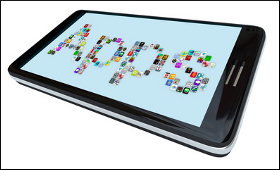|

|
Can mobile apps emerge sole driver of India's e-commerce?
|
|

|
|
| Top Stories |
 |
|
|
|
Aparajita Gupta and Sharon Thambala | 14 Jul, 2015
With 975 million mobile phone connections in India and penetration at 140 percent in urban areas, many e-commerce firms see apps as the way forward to push sales, with some even planning to make it their exclusive delivery platform. Is it feasible?
Industry stakeholders feel mobile apps are the way forward. But they cannot be the sole medium.
Recently, homegrown e-commerce major Flipkart, at an internal meeting, disclosed that the company planned to go the only-mobile-app-way by September. Earlier Myntra, which was acquired by Flipkart, also went app only.
"India is gradually transitioning from a mobile-first to a mobile-only country," a Flipkart spokesperson told reporter, alluding to the fact that net addition in fixed-line telephony in India had been in the negative for a few years now.
"At Flipkart, we have been following a mobile-first approach and 70-75 percent of our total traffic is already coming from our mobile app," the spokesperson said.
"We are constantly experimenting with various aspects of our service to create the best shopping experience for our users on our app. Meanwhile, we continue to offer desktop as well as mobile option for our customers," the spokesperson added, without going into the internal plan.
According to a study by PriceWaterhouseCoopers, only 10 percent of the mobile users in 2013 had smartphones and barely five percent of the ecommerce transactions were through a mobile device. This figure has more than doubled to 13 percent of all ecommerce transactions via mobiles.
"According to some industry players, over 50 percent of the orders are being placed through mobile apps, which is not only leading to substantial customer acquisition but also building customer loyalty for various brands," the study said.
But experts also said the regular computer-based e-commerce also cannot be ignored. According to Rajan Anandan, managing director of Google India, some 500 million people will be online in the country by 2018. The numbers in rural areas will top 210 million.
"We think app is the way to go but it shouldn't be the only medium," said Nasir Jamal, secretary general of eCommerce Association of India (ECAI), an umbrella organisation for the industry with over 100 members.
"This is because a considerable number of people still shop on their desktops. Since 3G, and now 4G, costs of mobile internet is still high, a large number of customers order through their PCs or laptops," said Jamal.
Asked whether going app only was a feasible proposition, he said: "When Myntra went app only in May, it reported a dip of about 10 percent in sales in the first month. Therefore, I will like to reiterate that app only platforms would lose out on a major chunk of revenues."
Another Indian e-commerce player, Snapdeal, said that it would focus on both platforms.
"At Snapdeal, the customer is at the centre of all initiatives. Our data shows there are still many customers who use PCs to shop online," said a Snapdeal spokesperson.
"We do not want to force our customers to use one specific medium to shop on Snapdeal. We will continue to offer our services on both PC and mobile. We do not see this changing in the near future," said the spokesperson.
The size of the ecommerce market in India is around USD 20 billion and it is growing at an average growth rate of about 40-50 percent per annum, according to ECAI.
According to Ankit Deb, co-founder of Bizongo, a B2B e-commerce platform that taps the plastics, chemicals and packaging markets, the mobile app is a strong and powerful tool because one is always logged in.
"The kind of people we deal with are suppliers, essentially small and medium businesses, who are probably not very tech savvy. But they have accounts in Flipkart, Snapdeal, Indiamart and such platforms," Deb said.
"Imagine a situation where instead of logging in again and again you are always online through an app which enables real-time, organic transactions and engagement. But that is missing on a Web site or a desktop. Organic engagement is a powerful tool, you can't do away with that."
(Aparajita Gupta can be contacted at aparajita.g@ians.in and Sharon Thambala at sharon.t@ians.in)
|
|
|
| |
|
|
|
|
|
|
|
|
|
|
|
|
|
|
| |
| Customs Exchange Rates |
| Currency |
Import |
Export |
US Dollar
|
84.35
|
82.60 |
UK Pound
|
106.35
|
102.90 |
Euro
|
92.50
|
89.35 |
| Japanese
Yen |
55.05 |
53.40 |
| As on 12 Oct, 2024 |
|
|
| Daily Poll |
 |
 |
| Do you think Indian businesses will be negatively affected by Trump's America First Policy? |
|
|
|
|
|
| Commented Stories |
 |
|
|
|
|
|
| |
|